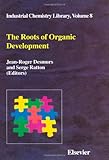The roots of organic development /
Collection : Industrial chemistry library ; . v. 8 Détails physiques : 1 online resource (xvi, 562 pages) : illustrations. ISBN :9780444824349; 0444824340; 9780080542621 (electronic bk.); 008054262X (electronic bk.).The development of organic intermediates requires high performance and original technologies. This book reviews recent work on some fifteen basic technologies in intermediates development including; hydrogenation, fluorination, chlorination, nitration, enzymatic catalysis, hydroxylation, alkylation, carboxylation and the Friedel Crafts reaction. Problems and industrial constraints involved in industrial development are highlighted from a research viewpoint and new technologies with potential for use in industry, particularly catalyst-based technologies clean chemical processes, are described. A chapter dealing with reviews on sodium amidure and polymerisation inhibitors is included.
Includes bibliographical references and indexes.
Description based on print version record.
Cover -- CONTENTS -- FOREWORD -- PREFACE -- ACKNOWLEDGEMENTS -- INTRODUCTION -- PART I: SYNTHESIS: ACYLATION -- Chapter 1. Friedel-Crafts acylation : interactions between Lewis acids / acyl chlorides and Lewis acids / aryl ketones -- Chapter 2. Bismuth (III) salts in the Friedel-Crafts acylation -- Chapter 3. Friedel-Crafts acylation of aromatics using zeolites -- Chapter 4. CoCl2 catalyzed trifluoroacetylation of aromatics using trifluoroacetic anhydride -- PART II: ALKYLATION -- Chapter 5. Catalysis by rare earth phosphate II : Selective O-methylation of phenols by methanol in vapor phase -- Chapter 6. Catalysis by rare earth phosphate III : Characterisation of samarium phosphate and samarium phosphate-cesium hydrogenophosphate as key catalysts for O-alkylation of phenols -- PART III: AROMATIC FUNCTIONALISATION -- Chapter 7. Selective functionalisation of fluoroaromatics via organosilicon intermediates -- Chapter 8. Arylation of amines and alcohols catalyzed by nickel, copper or palladium complexes -- Chapter 9. The isomerisation of 1,2,4-trichlorobenzene : a theoretical study -- PART IV: CARBOXYLATION -- Chapter 10. Carboxylation of hydroxy aromatic compounds -- PART V: CHLORINATION -- Chapter 11. Access to polychlorophenols, chemistry of intermediates -- Chapter 12. Diastereoselective halogenations -- PART VI: ENZYMATIC CATALYSIS -- Chapter 13. Enzymatic hydrolysis of adiponitrile into 5-cyanovaleric acid, an intermediate for Nylon 6 -- PART VII: FLUORINATION -- Chapter 14. Reagents with trifluoromethyl substituents -- Chapter 15. Fluorination of aromatic compounds by halogen exchange with fluoride anions ("Halex" reaction) -- Chapter 16. 4-Fluorophenol : a key intermediate for agrochemicals and pharmaceuticals -- Chapter 17. Fluorodecarboxylation of arylchloroformate : a new access to fluoroaromatics -- Chapter 18. Mild trifluoromethylation of organic compounds -- PART VIII: FORMYLATION -- Chapter 19. Formylation of aromatic compounds in superacidic medium -- PART IX: HYDROGENATION -- Chapter 20. High selectivities in hydrogenation of halogenonitrobenzenes on Pd, Pt or Raney Nickel as catalysts -- PART X: HYDROXYALKYLATION -- Chapter 21. Influence of the cation in condensation of glyoxylic acid on phenols in aqueous hydroxide solution -- PART XI: HYDROXYLATION -- Chapter 22. Selective access to hydroquinone <<Fuchsone>> route -- PART XII: NITRATION -- Chapter 23. The mechanisms of nitration of phenol -- PART XIII: OXIDATION -- Chapter 24. Oxidation of alkylphenols to hydroxybenzaldehydes -- Chapter 25. Large pore Ti-Beta zeolite with very low aluminium content : an active and selective catalyst for oxidations using hydrogen peroxide -- PART XIV: PEPTIDE SYNTHESIS -- Chapter 26. Peptide synthesis by SAPPHO technology -- Chapter 27. A new and practical removal of allyl and allyloxycarbonyl group promoted by water-soluble Pd(0) catalysts -- PART XV: SAFETY -- Chapter 28. Safety of chlorination reactions -- PART XVI: APPLICATIONS -- Chapter 29. Sodium amide in organic synthesis --T$1.


Il n'y a pas de commentaire pour ce document.